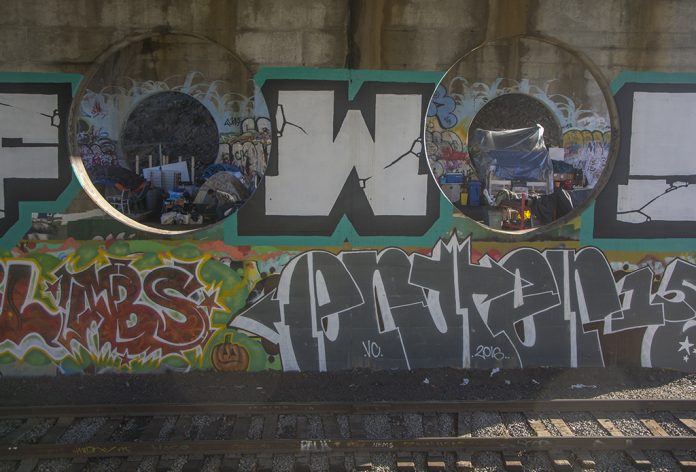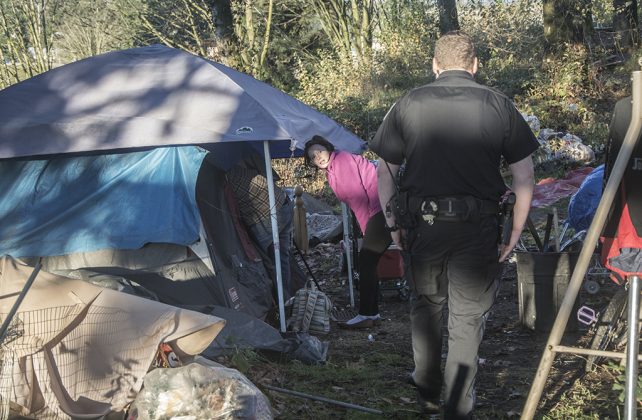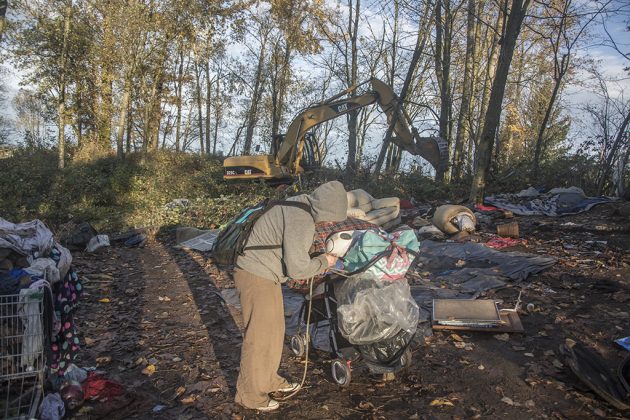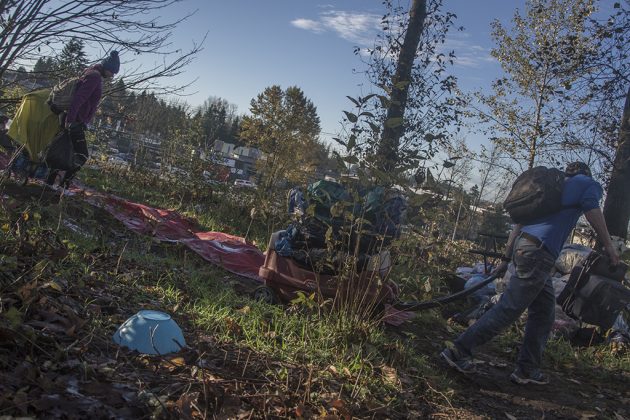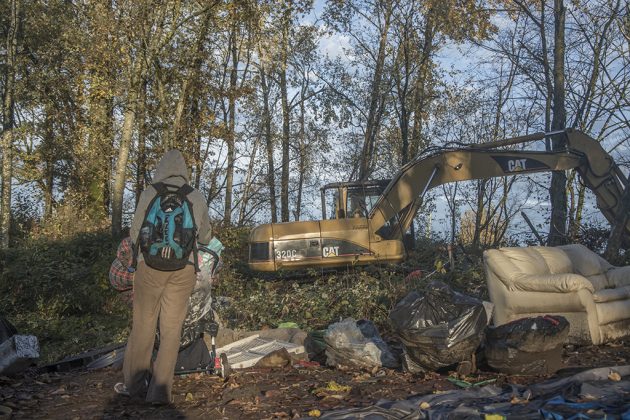I scramble up the brambly embankment in the dim morning mist, clacking metal like an army tank reverberates through the chill. Over the hill is a sparsely wooded area spotted with makeshift shanties and elaborately crafted campsites: layered tarps strung to uprooted tree roots, shabby tents, and rutted-tin lean-to’s. To my left, a young woman frantically bundles a sleeping bag into a shopping cart and rushes into a plywood shack. Downtrodden individuals speckle the forest, wordlessly rushing about, dragging boxes of personal knick-knacks and overloaded plastic wagons along the weaving mud trails. To my right, a 16-foot excavator rattles into the clearing, shepherded by a row of police officers and city workers marching into the homeless camp.
On Tuesday, November 8, the City of Abbotsford demolished a homeless encampment near the Peardonville overpass. Although they have cleared this site several times in past years, the eviction I witnessed last week, the surly orders shouted from city workers and police officers curt rebuttals to pleas for just a little more time, all seemed to harbour an air of vindictive weightiness. It’s not too difficult to comprehend why.
One week prior, on November 1, a homeless man walked off the street and into Abbotsford Secondary School with a knife. The accused is 21-year-old Gabriel Klein, who allegedly stabbed two young girls, killing 13-year-old Letisha Reimer in the hall outside of the library. Homelessness in the Fraser Valley has reached its tipping point.
Abbotsford is ranked the fastest growing homeless population in the province; according to a new report by health professors at UBC, SFU, and the University of Calgary, there are over 15,000 homeless people in B.C. with approximately 600 homeless in the Fraser Valley. The report only includes people with severe addictions and mental illness, and only those deemed “absolutely homeless”; it does not account for what some workers in the field refer to as “hidden homelessness”: those who do not show up at food banks and shelters to be tallied.
The general consensus on the street is that many of the homeless don’t seek help because they know there is nothing for them.
“Transition houses are maxed out; second-stage houses are at capacity, with one- to two-year waiting lists,” said a subcontractor for B.C. Housing who wished to remain anonymous. “The Salvation Army has 26 beds and Riverside has 40 beds and they’re all full.”
Sarah Fung, an outreach worker for 5 & 2 Ministries in Abbotsford, spoke about how this issue affects Abbotsford’s homeless population.
“Abbotsford has adopted a Band-Aid approach to everything,” Fung remarked. “Instead of dealing with the issue, we just try and maintain it. The homeless get kicked out of certain areas and then move somewhere else … We call it the Abbotsford shuffle.”
Many people working with the homeless in Abbotsford harbour a certain disdain for the city’s response — or lack thereof — to homelessness. Abbotsford is notorious for its churches, crime rate, and now, its homeless.
“Abbotsford has a bylaw in effect so that we can’t have a detox here,” Fung stated. “We can’t have any type of treatment centre. We aren’t even supposed to have harm reduction.”
The stout ideologies of citizens of the Fraser Valley could be hindering progress toward finding housing for the homeless.
“There’s an idea that the homeless community exists because of laziness or poor choices,” remarked Fung. “Some people think that if you pray over homelessness, or domestic violence, or addiction, that it will all just disappear.”
Evidence proves the reality behind homelessness is not so innocent. According to research presented at a “Health of the Homeless” summit in Vancouver, the overwhelming majority of B.C’s homeless suffered from mental illness and trauma-induced mental health issues long before they began living on the streets. The majority of B.C’s homeless suffer from schizophrenia, and more than half of the men and women who are homeless have suffered from both physical and emotional abuse, often at an early age, as well as fetal alcohol syndrome. Over 79 per cent of women living on the street were victims of sexual abuse.
Living on the street without structure or security is a horrific and deadly ordeal. According to a report done by The Megaphone, a counter-culture magazine sold by the homeless in Vancouver, at least 46 homeless people died in British Columbia in 2014 (the last time a count was conducted) — a 70 per cent increase from the year before. That’s someone dying on the street every eight days.
According to the report, the expiration date for a homeless person in B.C. is between 40 and 49 years of age; the average Canadian life expectancy is 82. The homeless are three times as likely to suffer an “accidental” death, and twice as likely to die by homicide and suicide than the general population. Leading causes of death among homeless people are: natural disease, drug poisoning, blunt injuries, hanging, and drowning.
According to Sean Condon, executive director of The Megaphone, the actual total of homeless deaths in B.C. could be twice as high; a homeless person dying in a hospital bed, or one who has sought temporary shelter, is not counted by the B.C. Coroners Service in the report.
But, I admit, it may be hard for people to give these issues their full attention amidst the difficulties of securing housing for themselves in an egregiously bloated market.
The homelessness issue has collided with a housing crises culminating into a crescendo of fear and loathing: fear that a 0.6 per cent housing availability sounds eerily similar to an ultimatum, and loathing for any suggestions of allocating hard-earned tax dollars towards supporting undeserving freeloaders. But, here’s the thing: you’re already paying for it.
Someone who lives on the street tends to be a regular consumer of police, ambulance, hospital, and other emergency services.
Research conducted for the Calgary Homeless Foundation estimates that the total cost a homeless person garners is $135,000 from the tax system each year. Multiply that amount by the approximate 15,000 homeless in British Columbia, and taxpayers in our province are paying approximately two billion dollars a year in order to maintain homelessness. The cost of sheltering someone in a supportive housing unit, according to B.C. Housing, is $37,000 a year.
Ending homelessness is not only a moral and ethical issue, it also makes good business sense.
The Cascade conducted an on-campus survey asking for students’ opinions on the homelessness issue. When asked what steps should be taken to combat homelessness, a majority of UFV students — 44 per cent — felt that using tax dollars to provide some form of housing should be the priority. The smallest minority of respondents, seven per cent, suggested we do nothing. The idea of providing housing to combat homelessness is a proven solution.
It’s called “Housing First,” a term used to quantify housing as a necessary precondition for mental health and drug addiction recovery, and not the other way around. Under a Housing First bylaw, the municipality would work with the province to provide housing — anything from subletting rooms in a house to a renovated and sectioned off shipping container — and offer safe space to everyone, regardless if they are “clean.” This provides stability and a structured environment for addicts to pursue recovery.
According to the research article Housing First — Where is the evidence?, the proof affirming this approach is overwhelming. Individuals who reside in a Housing First placement are healthier and more law-abiding than those who live in shelters or on the street. Housing First users are more likely to enroll in treatment for addiction or mental illness, and once in treatment they have a higher rate of success. Cities following the Housing First principles are seeing positive results — most notably the triumph of Medicine Hat, A.B. — so why isn’t Abbotsford following suit?
Housing falls under provincial regulation, meaning the municipal government has to fight for an audience with the B.C. government to convince them to allow their city to implement a Housing First bylaw.
“There’s a lot of passing the buck,” Fung noted. “It’s frustrating, because the city doesn’t want to deal with it, and when we try to pressure the government about implementing something that needs to be done, they step up and say no.”
Amidst all of this exasperating political gloom, Sarah points out a simple explanation: “The root of the problem is a lack of empathy,” she said.
I recall the city workers evicting the frail old woman. The excavator had already torn through several makeshift campsites. Fragments of fabric littered the ground. I followed two big city workers, gleaning some pesky satisfaction from their snorted side-glances as they tramped up to the multi-tarp shelter and tore open the front flap. She reminded me of my Aunt Martha, brittle, frizzy, spotted and creased with age. I thought she might be somebody’s grandmother, and my chest ached as she shouldered her threadbare bag and stepped lightly between the two men. I handed her my water bottle. She nodded, and I willed my heart into my eyes to smile love back at her.
“Could you live like this?” one of the workers asked pointedly, after the lady had gone.
I wanted to respond with biting scorn and wit and my mind raced, but all I said was “I don’t know.”
They peered inside the empty shelter. “Quite the kitchen, eh?” The older man said to the fat man, and they both guffawed their way down the trail.
“I think that it is really important that people know that the homeless are human beings that just want to be loved and to belong,” said Fung. “I had a pastor tell me once that love burns brightest in the darkness. The homeless community is not a community to be afraid of. They, amid their brokenness, possess a lot of things that society has forgotten: the sense of community and taking care of each other. They are loyal and loving people. They have a freaky exterior, but as soon as you get to know them they have hearts of gold.”
After the tragic events that recently unfolded in our city, it’s time for our community to take a stand towards ending the homelessness crisis.
The failed tactic of dismantling and degrading the homeless with the hopes of driving them into some form of ashamed surrender is no longer feasible. The cost is too great; the toll too dire.

